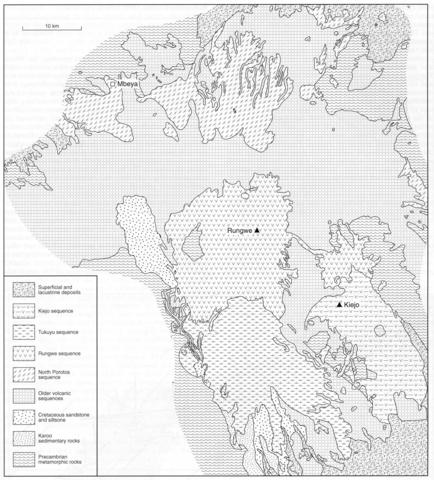stripes
The Rungwe volcanic rocks cover just over 3000 km2 but dispersed pumice and ash extend over a much wider area. The volcanism is located at the junction of the Nyasa-Rukwa and Ruaha rift systems. Harkin (1960) has recognised older and younger extrusive sequences each of which occupies about half the total area. The older extrusives are deeply weathered and eroded so that the eruptive centres can not always be identified; the younger, in contrast, often display well preserved volcanological forms and can be traced to volcanic centres. The younger volcanics are principally lavas but there is a high proportion of tuffs in the older series. Both series include basalt, trachyte, phonolitic trachyte and phonolite, but melanephelinite, tephrite and basanite are confined to the younger series. Katete is probably the oldest volcano in the province but it does not have a conical form and there is now no sign of a crater; exposure is poor but it appears to be built mainly of phonolite. Across the northern part of the province are the Poroto Mountains where volcanic activity may have been contemporaneous with that of Katete, and where many eruptive centres were involved, only a few of which can be recognised. The focus of activity was Ngozi which is conical in form and contains a caldera with a lake of 2x1.2 km. The caldera walls are of phonolitic trachyte and phonolitic tuffs and lavas, and blocks of syenite up to 30 cm across are abundant in the vicinity. Other centres are described by Harkin (1960) and although a little basalt is present they are principally trachytic or phonolitic. There are four principal sequences making up the younger series (Harkin 1960). The North Porotos sequence was erupted from many centres and is dominantly of lava with some flows more than 30 m thick. Basalts occur towards the base and top of the general succession, but phonolite and phonolitic trachyte are predominant with quartz trachyte flows also present. From the two well preserved cones of Izumbwe and Mpoli lavas of olivine melanephelinite and melilite-olivine melanephelinite were erupted. The Tukuyu sequence comprises mainly basalt but there are some intercalated phonolite flows. The Rungwe sequence is centred on the Rungwe volcano which is the largest of the province its products extending over more than 500 km2. Rungwe is a central volcano built mainly of lavas and tuffs of phonolitic trachyte which overlie Katete phonolites and Tukuyu basalts. The caldera of Rungwe has a greatest diameter of 4 km, but the western wall has been destroyed by later eruptions. Large volumes of basalt were erupted from centres low on the northwestern flanks, one flow being more than 30 m thick, and lahars, probably related to the main crater-forming phase, are found to the west. The last phase of phonolitic trachyte lavas, pumice and ash built a series of subsidiary volcanoes within the breached caldera. The fourth sequence of the younger series is centred on Kiejo which is conical in form and has a summit crater. An earlier basaltic phase is overlain by phonolitic trachyte and trachyandesite, which comprise the main cone-building phase, and then by ankaramitic basalt, followed by a younger basaltic sequence. The last eruptions came from several centres which coalesced to form a 7.5 km long flow. There are numerous hot springs in the area south of Kiejo. Detailed petrographic accounts of all rock types are given by Harkin (1960). Basalts of both the older and younger series are normally olivine-phyric; a little nepheline is sometimes present and analcime may by interstitial. These rocks grade into basanite and tephrite, both having abundant nepheline. The tephrite of Kiejo is pyroxene-phyric, has rare olivine and common barkevikite phenocrysts; the pyroxene phenocrysts generally have aegirine-augite cores and titanaugite rims. The melanephelinite of the North Porotos sequence consists of abundant phenocrysts of augite and olivine in a matrix of augite trending to aegirine-augite, interstitial nepheline, opaques and rare olivine. In the melilite-bearing rocks the melilite takes the place of about half of the pyroxene and comprises approximately a quarter of the rock. The phonolites of both the older and younger series include aphyric and phyric types, common phenocrysts including alkali feldspar, nepheline, aegirine-augite, barkevikite and rarely nosean or hauyne. Pyroxene phenocrysts may have titanaugite cores which pass successively into aegirine-augite and aegirine. Other phases variably present include a sodic amphibole, matrix sodalite, biotite, opaque phases, apatite and titanite; quartz is found in some trachytes. Numerous chemical analyses of rocks are tabulated by Harkin (1960). A detailed geochemical study of the mafic lavas - basalt, basanite and nephelinite - has been made by Furman (1995) who presents many analyses with much trace element, including REE, data.
FURMAN, T. 1995. Melting of metasomatized subcontinental lithosphere: undersaturated mafic lavas from Rungwe, Tanzania. Contributions to Mineralogy and Petrology, 122: 97-115.HARKIN, D.A. 1960. The Rungwe volcanics at the northern end of Lake Nyasa. Geological Survey of Tanganyika, Memoir, 2: 1-172.

